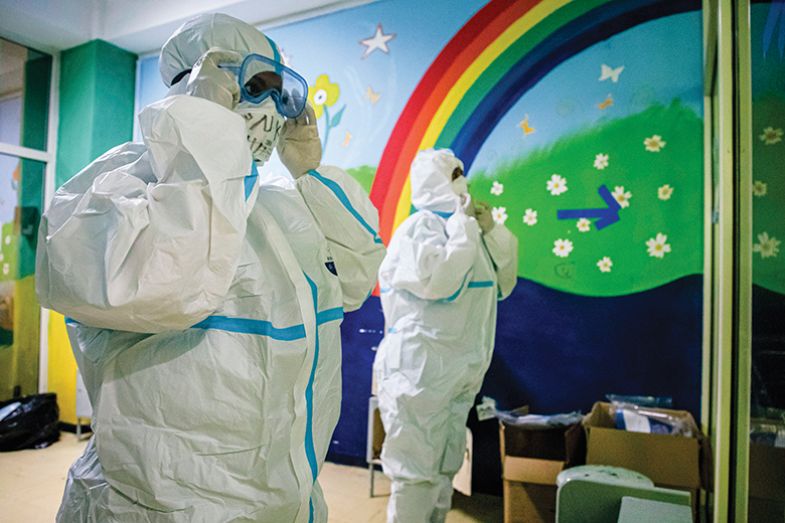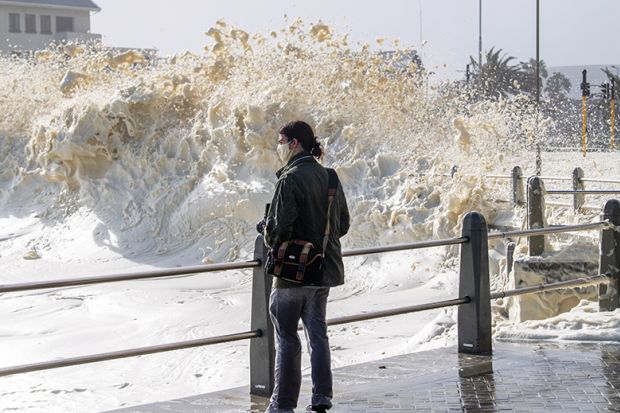Browse the full THE Emerging Economies University Rankings 2021 results
Many higher education systems and institutions in emerging economies have made great strides in their research and teaching performance in recent years. But to what extent will the pandemic halt this progress and widen inequality between universities in rich and poor nations?
One region where the impact of Covid-19 appears to have been less severe, at least in terms of the death rate, is Africa. This has been largely attributed to swift and drastic public health measures by governments, which have been strongly supported by the public; the continent’s young population; and its favourable climate.
“To a certain extent, it’s a big advantage that Africa has got such a young population, which will become [even] younger compared with other parts of the world over the next few decades,” says Goolam Mohamedbhai, an independent consultant in higher education and former secretary general of the Association of African Universities.
“But there are two sides to it. While this can be an advantage, if you do not make use of the potential of this youth and do not provide them opportunity, then it can be a real challenge and problem.”
Mohamedbhai says that, despite improvements over the past 30 years, university teaching in many African institutions has suffered from “too many students and not enough resources”.
Download a free copy of the Emerging Economies University Rankings 2021 digital supplement
The forced and sudden shift to remote learning since the outbreak of Covid-19 has delivered another blow to teaching quality, not helped by the fact that the level of inequality among students, institutions and countries is particularly stark in Africa compared with other regions.
“The majority of higher education institutions in Africa were not prepared to go online,” he says. “In some cases, poor students in rural areas do not have electricity, let alone internet.”
Mohamedbhai believes that teaching quality will “probably stabilise”, but he worries that research will take a longer-term hit. Africa already has the poorest research output of any region in the world, he notes, and many research projects have stalled amid the pandemic.
“Many PhDs candidates have suffered because they could not carry on with their research and access laboratories. South Africa has suffered badly, in particular, because it is the one country that attracts a lot of PhD candidates from other parts of Africa. These students have had to go back to their country [or have been] stranded in South Africa and can’t carry on with their work. All of this causes a lot of problems,” he says.
Mohamedbhai adds that doctoral education and research in the region relies heavily on external funding, and it is unclear whether these income streams will continue at the same level post-pandemic.
“Most countries in the north have their own problems. When you have a crisis like this, you have to ensure that everything is all right at home [first] and then you look overseas,” he says. “I’m really worried that this will lead to a slowdown in research activity in Africa.”

In eastern Europe, Liviu Matei, provost of Central European University and a professor of higher education policy, is also pessimistic about the future. While he says that the increased attention to and improved attitudes towards technology, online learning and remote collaboration are a “positive development” that might help to expand access and cooperation in the future, he admits that he cannot “find one single more positive aspect with regards to research coming out of the crisis”.
Matei says higher education in former communist countries in eastern Europe has improved in recent years. However, there is “still a big gap in terms of research activities and research outputs between the east and west”, and the pandemic only “exacerbates this deficit”.
“Universities and public authorities are focusing on addressing the most immediate aspects of the crisis, like access and pedagogy. Research is not in the centre of their attention and probably less [important] than it used to be,” he says. “This is what happens every time there is a major crisis – the attention of almost everybody involved is focused on a smaller number of issues, the ones that are most urgent.”
Matei believes that academic freedom is another victim of this tendency to “forget the pre-existing conditions and concentrate on what is most immediate” during a crisis.
“There is a crisis of academic freedom in Europe, [but] talking about academic freedom sounds almost like a luxury in current times. However, without academic freedom there can be no research, there can be no good teaching, there can be no higher education,” he says.
Matei says the increased isolation of individuals and institutions during the pandemic also disproportionately harms universities in emerging economies.
“Almost everybody is trying to address the problems that arise from the crisis alone. All this talk about networks and consortia – it is predominantly just talk,” he says. “When you have to address a crisis of this magnitude alone, it makes a difference whether you are a rather fragile university from the east or a powerful better-established university from the west.”
Restrictions on travel and physical meetings are one reason for solitary working, Matei says, but government responses are also a factor. States are concerned primarily with the citizens and institutions of their country and “not interested in supporting international collaboration”, either financially or by other means, during the pandemic, he says.
However, Matei says his institution is tackling the issue of student recruitment collaboratively. CIVICA, an alliance of eight European institutions, including CEU, is allowing students at the member institutions to also study at any of the other members if they are unable to travel because of the pandemic.
“If there was a Pakistani student admitted to a master’s course at [CIVICA member] the LSE [London School of Economics], but he did a bachelor’s in Hungary and was stranded here, we at CEU in Budapest would allow him to attend the courses online at the LSE but also attend courses in person or online at CEU,” he says.

A region that could be seen as a complete contrast to Africa and eastern Europe in terms of its higher education trajectory is Asia. East Asia in particular has been steadily improving on research, and many experts have predicted that the continent is likely to play an even more significant role in global higher education post-pandemic.
Hamish Coates, a professor in Tsinghua University’s Institute of Education told Times Higher Education in December that about two-thirds of higher education will be in Asia by 2030, while others have suggested that east Asia will emerge as a regional hub for international student mobility and that countries such as China and Malaysia might become major competitors to anglophone systems.
But how are Asian nations with less developed higher education systems likely to fare?
Gerard Postiglione, emeritus professor of higher education at the University of Hong Kong and coordinator of the Consortium for Higher Education Research in Asia, believes that one emerging area to watch is the Asean (Association of South-East Asian Nations) region, which includes Brunei, Cambodia, Indonesia, Laos, Malaysia, Myanmar, the Philippines, Thailand and Vietnam, as well as the more developed Singapore.
“That region is going to be the fourth-largest economy in the world by 2030. Population-wise, it is also an extremely large sector of the world and it’s urbanising very rapidly,” Postiglione says.
“What’s happening in those countries is that basic education has kicked in, the demand is going up, and they are now trying to build strategies on how to handle mass higher education. The question is how to spend the money and have world-class universities.”
Postiglione also highlights a less discussed nation, which could benefit from the fact it borders both China and Russia: Mongolia.
“This place is starting to take off, partly because they’ve got every mineral that’s on the market. The government has decided to build research-intensive universities, and they’ve moved to mass higher education,” he says.
Postiglione believes that rapid acceleration of technology “makes it possible for developing countries’ universities to enter global knowledge networks” in a way they have not previously, while the increasing drive among top universities in developed countries to solve global problems means they are ever more reliant on data from institutions in emerging economies.
“To deal with world problems – whether it’s global warming, pandemics, inequality, poverty – you need to connect. So I think the timing is right for countries such as Mongolia,” he says.
However, Postiglione adds, there are several challenges, besides Covid, that both Asean nations and Mongolia will need to overcome to develop their higher education systems. These include improving teaching quality as the system moves from elite to mass higher education and is increasingly funded by households rather than the state; shifting from direct government control of institutions to a more autonomous governance system; implementing internal and external quality assurance systems; ensuring that higher education remains affordable; and taking advantage of advances in technology.
“These things are really going to be difficult for developing countries, but the momentum of change is there,” he says.
As for the impact of Covid-19, Postiglione says, on the one hand, it means that governments are likely to spend less on higher education and that many families will find it harder to afford university. But, on the other hand, some students who previously went overseas for their education might now remain in the domestic system to save money.
“Overall, it would seem that Covid has not been helpful for fulfilling the aspirations of ministries of education in developing countries for building research-intensive universities and for instituting expensive quality assurance and internationalisation strategies,” he says.
But despite concerns that the pandemic will widen inequality between institutions in emerging and more developed higher education systems, Mohamedbhai says history gives some cause for optimism.
“Africa was brought to its knees in the 1980s partly because of lack of funding and partly because of what was happening in the countries – poor management, corruption, wars. You look at some of the really good universities in Uganda, Senegal, Zimbabwe – they almost collapsed, but they came [back] up,” he says.
“So I do hope that higher education institutions will come up and fight for their own survival. Because their survival is the survival of their own country.”
POSTSCRIPT:
Print headline: It’s an ill wind that blows no one any good
Register to continue
Why register?
- Registration is free and only takes a moment
- Once registered, you can read 3 articles a month
- Sign up for our newsletter
Subscribe
Or subscribe for unlimited access to:
- Unlimited access to news, views, insights & reviews
- Digital editions
- Digital access to THE’s university and college rankings analysis
Already registered or a current subscriber? Login







